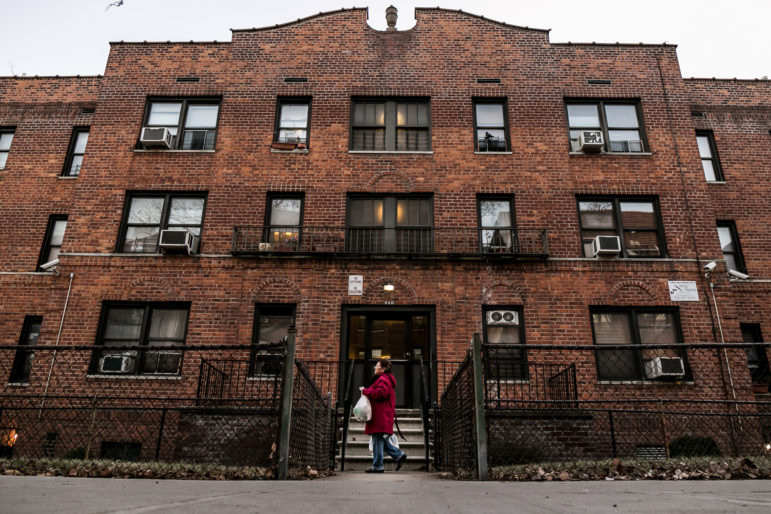The Concept of Community: Lessons from the Bronx, by Harold DeRienzo, IPOCPress, $38.
Visiting the Longwood-Hunts Point neighborhood in the South Bronx today, it’s hard to remember that only 30 years ago it looked like Dresden after the bombing, with abandonment the dominant characteristic. Today, a mix of new and old three- to eight-story apartment houses lines Kelly, Fox, Beck and Dawson Streets and Prospect Avenue. A once-empty school houses the thriving Banana Kelly High School, a lush green park is filled with trees showing solid age, and well-used playing fields occupy a vast space where rubble once dominated. The number of local businesses is increasing. Developer-built infill housing is scattered around. A beautifully restored elevated subway station anchors the district. And an ethnically and economically diverse population proudly calls the area home, a far cry from the day when departure was a universal goal.
My first visit to Kelly Street was in 1977. I was taken there by Ron Shiffman, a founder of the Pratt Center for Community Development. The purpose was to witness a mostly burned-out neighborhood for research I was doing on urban regeneration – because it turned out that beneath the dust, seeds of revitalization were just beginning to sprout. Experts had declared the area hopeless, beyond repair, an obvious candidate for demolition and “planned shrinkage” – a form of official redlining to force evacuation of targeted neighborhoods by withdrawing city services. Property owners, government and financial institutions had long since abandoned this once vibrant, densely populated middle-class community; the bleak landscape was an international poster child for extreme urban decay.
Under siege is an understatement for what I saw. Scattered abandoned buildings stood amid blocks upon blocks of mostly rubble-strewn lots. Vacant stores, an empty school and mounds of garbage filled the view – the typical condition of so much of the South Bronx in the post-urban renewal and highway clearance decades following World War II.
Hope was hard to find. Yet it sparked among a small group of highly motivated local residents determined to turn the place around. They didn’t know better than to believe it could be done. And they were led by a determined 23-year-old social worker named Harry De Rienzo.
Banana Kelly, they called themselves, in honor of the curve of Kelly Street where they started a long-term reclamation effort one building and one block at a time. “Don’t Move, Improve” became their motto, later adopted by community-based groups around the country inspired by the eventual success of Banana Kelly Community Improvement Association, Inc., and signaling a new brand of community development.
Now, 30 years later, De Rienzo has written a terrific book, “The Concept of Community: Lessons From the Bronx,” a book that tells the incredible story of how Banana Kelly was one of the critical successes lighting the way for the community-led resurgence of the Bronx – a resurgence initiated by local people whom everyone officially had given up on. This self-organized, citizen-motivated movement made it possible for developers and investors to follow (and then attempt to take full credit for the rejuvenation visible today).
In 1977, one just had to believe in the impossible: The city was bankrupt. Landlords were fleeing. No banks had any stake in the area. And the court system offered no help. There was no one to protest against.
“The only alternatives,” De Rienzo writes, “were to flee or to take on the problems ourselves, and to me, this recognition marks the true beginning of the community development movement in the South Bronx and similar inner city areas.
“Should Banana Kelly fight against some faceless landlord, dysfunctional government agency or uncaring bank or insurance company? This seemed pointless. Instead, we decided to save, rebuild, and sustain our community on our own.”
In under 20 years – less time than it takes to conceive, plan and implement most official urban renewal projects – Banana Kelly had indeed turned the place around: It managed more than 1,000 housing units in 47 buildings worth more than $60 million, rehabilitated well over 1,000 affordable units, employed 100 skilled and unskilled local residents, supervised weatherization and repair programs, ran a youth construction and building maintenance training program, and provided an assortment of social, physical and economic services in the 150-block area of Community Board 2. Foundations supported it. Government officials gave belated recognition and support. Then, everything fell apart under board chair Yolanda Rivera, who also became CEO in the 1990s. The press, which hardly recognized the earlier extraordinary success, spotlighted the failure of this citizen-led effort but not its subsequent renewed success.
De Rienzo had left in 1982, first to go to law school and then to become president of the Parodneck Foundation for Self-Help Housing and Community Development (where he presently serves as general counsel) but was called back into service in 2002 by the state attorney general’s office after an investigation found an assortment of wrongdoings and financial abuses under Rivera. With former Borough President Freddie Ferrer as the new board chair, De Rienzo was put in charge of setting things straight as president and treasurer. Once again, De Rienzo confronted crime, disrepair, missing doors, inoperable heating systems, mold, mountains of debt and rent strikes. And once again, he led Banana Kelly to a fully functional and successful level. Today Vera Rosario ably leads the organization as executive director.
Six years later, the group is back on track again and the neighborhood is showing the best sign of stability – the opening of new businesses, both locally owned and chain stores. A flower shop, printing service, three pharmacies, a locksmith and a supermarket all have opened not far from Kelly Street. Vacant storefronts are hard to find.
But this book does more than recount the success, collapse and renewed success of Banana Kelly. De Rienzo uses the story of Banana Kelly and other Bronx successes – such as the Mid-Bronx Desperados, the Longwood Historic District Association and the South Bronx Community Housing Corporation – to illustrate the real value of empowering communities to make good choices, the nature of appropriate government and foundation support, and the basic functions a community development organization must serve beyond providing shelter. He explores the distinctions between “neighborhood” and “community,” the need for community first before the building of institutions is possible, and the difference between a community development corporation that just provides housing and one that has an integrative purpose serving an assortment of community needs.
Well-written in a way that a newcomer to Bronx lore might learn from, this book is useful as both recent New York history and as a primer for activists and supporters alike. It suffers from the lack of an index, which could be a useful guide to specific topics, and sometimes gives only a capsule version on a subject about which one might like to know more. But it covers many aspects of relevance to the period, such as the impact of President Jimmy Carter’s South Bronx visit and the setbacks under President Ronald Reagan. He reminds us of the great achievements of the city’s “in rem” housing (meaning occupied, tax-foreclosed) program that reclaimed thousands of affordable housing units. And it covers decades of successful bottom-up regeneration with lessons too quickly forgotten.
The major drawback of this story as a national example is that New York City sits in stark contrast to cities elsewhere where abandonment and vacant useful housing are still the norm. The New York of the 1970s is gone. No vacant, undervalued areas are left, where local residents can take control of property and conditions under the radar of city officials. Today the challenge is over-success and the opportunity-hunting of developers taking advantage of massive upzonings citywide. Much of De Rienzo’s analysis of effective community-based action still applies – but the need for adjustments to current conditions is huge.
This is a must-read for people from New Orleans to Youngstown, Ohio who think the solution to diminished population and abandonment is demolition – these days called “creative shrinkage,” which is just a euphemism for planned shrinkage. Planned shrinkage would have let the Bronx and other beleaguered city neighborhoods continue to rot into oblivion. Local people resisted, proved the experts wrong and are responsible for today’s success. They proved both the unrecognized capacity of empowered local citizens and the effectiveness of a public policy that reflects community wisdom and experience.
“Ultimately,” De Rienzo writes, “the Bronx was revived as a result of substantial public subsidies, an extensive infrastructure of community development corporations, and local leadership that focused on results and not on patronage.”
The lessons are as pertinent today as they were 30 years ago. The only difference is that then the lessons were yet to be learned. Now, they are as clear as day.
Roberta Brandes Gratz is an award-winning journalist and chairman and founder of The Center for the Living City at Purchase College. She wrote the books “Cities Back From the Edge: New Life for Downtown” and “The Living City: Thinking Small in a Big Way,” in which the Banana Kelly story plays a central role.
“The Concept of Community” is not stocked at bookstores, but can be ordered online at Amazon.com, Powells.com, or Barnes and Noble.







